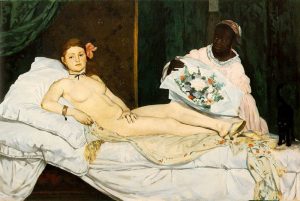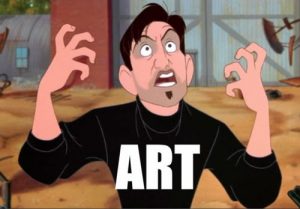Is “50 Shades of Grey” Immoral? Does it Matter?
Have you ever heard someone say that Twilight is a terrible movie because it presents stalking and emotional co-dependency as desirable? Or that 50 Shades of Grey is an awful book because it eroticizes abuse? I have. Every time someone criticizes such pop culture phenomena on ethical grounds, they’re making the assumption that good art has to be good for something — in most cases, that something is morality. But what’s this assumption grounded on?
Let’s talk about Noel Carroll, a philosopher of art, and the 20-year-old dispute he started.
The debate, politely confined to academic journals, was initiated by Carroll’s explication of his position as a moderate moralist. Here’s what this means: Carroll begins with the observation that many artworks inspire moral responses in their audience, thereby encouraging interpretation and evaluation of themselves in moral terms. For Carroll, such responses are often not prescribed by the work, but already present in the minds of audiences. Numerous presuppositions are required of spectators and readers, who arrive with assumptions and then utilize them to complete narrative gaps. For example, Shakespeare needn’t explain why Hamlet is outraged at his father’s murder. King Lear’s disappointment in Regan’s ingratitude is taken as a matter of course, since ungrateful children are tacitly understood to be disappointing. In fact, narratives are often unintelligible without the audience’s preconceptions: unless one finds the social ostracism of Anna Karenina both inevitable and distressing, Anna’s suicide becomes incomprehensible. Thus, Carroll explains, it is a typical element of artworks to “activate” existing moral emotions, without which the work will be inaccessible to the viewer (whether some works deliberately strive for inaccessibility is a related, but separate, notion). Given sufficient moral flaws, Carroll posits, the activation does not take place, and the work remains beyond intelligibility. Since an antecedent moral understanding is a prerequisite of art’s audience, Carroll concludes that moral evaluation is implicit in aesthetic engagement.
Carroll’s second bulwark for moderate moralism relies upon an Aristotelian conception of proper tragic character. In his Poetics, Aristotle proposes that the plot tragedy offers “must not be the spectacle of a … bad man passing from adversity to prosperity … it neither satisfies the moral sense, nor calls forth pity or fear.” Moral defectiveness, in other words, must not be presented without its just punishment, or, what amounts to the same thing, without a moralizing message. Without it, the audience cannot sympathize with the artwork. If a work strives to arouse pity and fear, as proper tragedy should, the substance of the work must be morally sympathetic.
Venturing where Aristotle points, Carroll introduces the uncontroversial thesis that achieving the desired audience response is an integral feature of successful artworks. However, if a work which aims at the audience’s pity is so ethically inappropriate that it prevents emotional “uptake,” it cannot achieve the desired pitying response because it has “invited the audience to share a defective moral perspective.” Thus, the portrayal of certain unethical attitudes, since it precludes the hoped for aesthetic response, forces the artwork to fail qua art. Invoking the incorrect “bad man passing from adversity to prosperity” formula, Carroll imagines a dramatic representation of Hitler as a sympathetic character. Such a representation must founder in its own emotional inaccessibility, Carroll argues, because the audience cannot summon the necessary sympathy for such a morally objectionable figure. In the simplest terms, the artwork remains beyond sympathy because the audience “doesn’t get it.” For Carroll, emotional remoteness occasioned by the “failure to achieve uptake” is an aesthetic failure precisely because it is a moral failure. Linking the capacity to achieve uptake with his assertion that audiences complete works by contributing an implicit ethical understanding, Carroll concludes: “Securing the right moral response of the audience is as much a part of the design of a narrative artwork as structural components like plot complications. Failure to elicit the right moral response, then, is a failure in the design of the work, and, therefore, is an aesthetic failure.” With this elegant formulation, Carroll defends a moderate moralism which guards the inextricability of ethical from aesthetic value. In other words, if we think that stalking or sexual domination are unethical, then Twilight and 50 Shades fail aesthetically by failing ethically.
But is it convincing?
Let’s begin by examining Carroll’s first supposition: artworks “activate” existing moral emotions, and if the activation doesn’t take place, the work remains inaccessible. One must understand Hamlet’s outrage at his father’s murder, for example, in order to understand the play. If one believed that murdering fathers was a common or even a cheerfully encouraged practice, Hamlet’s plot would become nonsensical.  Thus, Shakespeare activates our ethical sense by summoning the common knowledge that murder, particularly when applied to family members, is wrong. Very well. But doesn’t Hamlet also activate our biological sense by relying upon our common knowledge that humans are mortal? Is not this sense further activated by Shakespeare neglecting to mention that his characters drink water and use the restroom? The audience is not surprised when Hamlet does not sit down to a single square meal for the long months of the play’s action because the fact that he must be eating is implicitly understood. In fact, there is a myriad of implicit understandings with which an audience arrives at an artwork – biological, historical, cultural, psychological, and even scientific. If the activation of ethical norms is a standard feature of artworks, then so is the activation of biological and historical norms, without which the work may be incomprehensible. This is true, but trivially so. Unless, along with ethics, we are prepared to admit biology, history, and science into the summary of aesthetic value, such implicit understandings, while necessary, are nevertheless not aesthetic features. But wait, an attentive objector might cry, Carroll’s formula regards ethical norms as aesthetic features only if eliciting such norms is part of the design of the work. Again, this is only trivially true. If it’s essential to the design of Hamlet that we reject murder, it’s equally essential that we accept mortality or the undesirability of death because, without them, the plot’s design is not possible. Surely, we are not prepared to admit “moderate biologism” or “moderate psychologism” along with Carroll’s moderate moralism into the scope of art critical standards.
Thus, Shakespeare activates our ethical sense by summoning the common knowledge that murder, particularly when applied to family members, is wrong. Very well. But doesn’t Hamlet also activate our biological sense by relying upon our common knowledge that humans are mortal? Is not this sense further activated by Shakespeare neglecting to mention that his characters drink water and use the restroom? The audience is not surprised when Hamlet does not sit down to a single square meal for the long months of the play’s action because the fact that he must be eating is implicitly understood. In fact, there is a myriad of implicit understandings with which an audience arrives at an artwork – biological, historical, cultural, psychological, and even scientific. If the activation of ethical norms is a standard feature of artworks, then so is the activation of biological and historical norms, without which the work may be incomprehensible. This is true, but trivially so. Unless, along with ethics, we are prepared to admit biology, history, and science into the summary of aesthetic value, such implicit understandings, while necessary, are nevertheless not aesthetic features. But wait, an attentive objector might cry, Carroll’s formula regards ethical norms as aesthetic features only if eliciting such norms is part of the design of the work. Again, this is only trivially true. If it’s essential to the design of Hamlet that we reject murder, it’s equally essential that we accept mortality or the undesirability of death because, without them, the plot’s design is not possible. Surely, we are not prepared to admit “moderate biologism” or “moderate psychologism” along with Carroll’s moderate moralism into the scope of art critical standards.
Now let’s consider Carroll’s second supposition: achieving the desired audience response is a standard feature of successful artworks. While this seems self-evident, it does not follow that if the desired response is an ethical one, the artwork’s failure to achieve it is also ethical. Invoking Brett Easton Ellis’ novel American Psycho, Carroll recounts that it was intended as a satire, but the coldly disturbing descriptions of murders were regarded as so morally offensive, that audiences were unable to see the novel’s ironic elements: “American Psycho’s failure to achieve uptake as satire is attributable to Ellis’ failure to grasp the moral inappropriateness of regarding his serial killer as comic.” Carroll argues that such works fail because they ask the audience to “share a defective moral perspective” where the nature of the work itself calls for a proper moral perspective. However, this contradiction lies not in ethics, but in aesthetics. When Hamlet’s dead father appears in contemporary productions of the play as a transparent phantom, the audience is asked to entertain an unscientific point of view. Ghosts, common knowledge tells us, do not exist. The play asks us to temporarily believe, for its sake, that they do. Despite common knowledge, the audience plays along.  If the scene’s special effects become excessive, with, say, transparent sheets flying to and fro, the childish absurdity of believing in ghosts might overcome the power of the play to move us. In such a case, it would not be the unscientific nature of ghosts, but the way ghosts are presented, that prevents tragic uptake. It would not be the content, but the form, of the work that would become objectionable. These would not be scientific defects, but aesthetic ones. Similarly, if the audience does not play along with American Psycho’s killer, it is not a moral failing, but an aesthetic one. It isn’t that the novel portrays a killer, but rather that it does so badly. Killers need not be justly punished for a novel to “work” at securing uptake, but they must be presented in ways which accord with aesthetic sensibilities. Had Ellis been a stronger artist, the immoral content of his novel may have been transcended by its aesthetic form. Shallower works sometimes founder in the gap between form and content which powerful works are capable of reconciling.
If the scene’s special effects become excessive, with, say, transparent sheets flying to and fro, the childish absurdity of believing in ghosts might overcome the power of the play to move us. In such a case, it would not be the unscientific nature of ghosts, but the way ghosts are presented, that prevents tragic uptake. It would not be the content, but the form, of the work that would become objectionable. These would not be scientific defects, but aesthetic ones. Similarly, if the audience does not play along with American Psycho’s killer, it is not a moral failing, but an aesthetic one. It isn’t that the novel portrays a killer, but rather that it does so badly. Killers need not be justly punished for a novel to “work” at securing uptake, but they must be presented in ways which accord with aesthetic sensibilities. Had Ellis been a stronger artist, the immoral content of his novel may have been transcended by its aesthetic form. Shallower works sometimes founder in the gap between form and content which powerful works are capable of reconciling.  After all, great works ask audiences to identify with rascals and villains very frequently. Let us consider the icy cruelty of Iago, whose soliloquy nevertheless manages to elicit empathy, or the pickpocketing Artful Dodger, whose criminality seems comical. Since Iago is one of the coldest villains in literature, it’s certainly not his congruence with ethical understanding which encourages “uptake” of Othello, but rather Shakespeare’s aesthetic choices which move us despite, or perhaps because of, their disturbance of implicit moral knowledge.
After all, great works ask audiences to identify with rascals and villains very frequently. Let us consider the icy cruelty of Iago, whose soliloquy nevertheless manages to elicit empathy, or the pickpocketing Artful Dodger, whose criminality seems comical. Since Iago is one of the coldest villains in literature, it’s certainly not his congruence with ethical understanding which encourages “uptake” of Othello, but rather Shakespeare’s aesthetic choices which move us despite, or perhaps because of, their disturbance of implicit moral knowledge.
To illustrate this further, let’s imagine the feminist philosopher Marcia Muelder Eaton lingering near a lake in Minneapolis. Beside the water, the loose strife flower blooms. Frothy purple blossoms cling to slender stems. The flower, Ms. Eaton thinks, is beautiful. Then, she recalls that the exotic plant invades wherever it takes root, swiftly ruining water purification processes for other plants and animals and destroying the delicate ecosystem. She writes, “I know that it is a dangerous, even evil, plant … But I cannot prevent myself from finding the plant quite beautiful.” Despite its ruthlessness, the flower is beautiful, and its destructiveness perhaps only makes this conflict more pronounced and therefore more aesthetically forceful. In Carroll’s parlance, the purple flower contradicts implicit moral knowledge. Nevertheless, it achieves uptake in Ms. Eaton’s mind. This ethical dilemma of beauty in evil is at the very heart of Carroll’s critique. It is, however, an ethical dilemma. American Psycho is unlike the loose strife flower because it lacks aesthetic, not moral, goodness.
Perhaps the most notorious example of an “evil” artwork is Leni Riefenstahl’s Triumph of the Will, a glorification of Nazi Germany which enjoyed an overwhelmingly positive reception, though certainly not because it was more moral than American Psycho. The film, made at Hitler’s request, focuses upon the 1934 Nuremberg party rally sponsored by the Nazi Party. Brilliantly orchestrated montages of thousands of troops, marching bands, parades, and speeches flowing to the cadence of Wagnerian music create a stunning spectacle.
The film was successful not only in Germany, but won the Gold Medal at the Venice Film Festival and the Grand Prix at the Paris Film Festival, and is still regarded as a supreme cinematic achievement. The controversy, of course, is explicit. The representation of ecstatic crowds adulating Hitler, who is portrayed as a redeeming figure graciously accepting bouquets from laughing children, culminates in a vision of Nazi Germany as desirable and, quite simply, good. The Triumph of the Will is also unlike the loose strife flower, but not because it lacks aesthetic force. Unlike the flower which prompts us to set aside its destructive nature for the sake of appreciating its formal beauty, the glorification of Nazism structures the work as a whole. Content and form merge: we cannot set aside the content of a messianic Hitler because that content is precisely what forms the film into the kind of film that it is. Here, Carroll would likely insist that when content becomes paramount, aesthetic evaluation is helpless and ethical evaluation must take the reins. However, this is misguided. A purely formalistic survey, wherein we are asked to bracket the film’s veneration of Hitler in order to appreciate only its stylistic features, is not the only aesthetic approach. Form and content are reconciled in exploring how stylistic features convey substance, such that the entire expression of the work is included in aesthetic evaluation. Instead of setting aside the vision of Hitler’s goodness, we assess how that vision is communicated. Much like Othello is canonized not in spite of Iago’s treachery but partially because of it, the film succeeds aesthetically not in spite of its message, but partially because of it. Asking whether the historical Hitler is as messianic as he is represented is like asking whether space travel really occurs as instantaneously as it does in science fiction novels. The magical realism of Borges, wherein tigers are willed into existence and dead men play the gramophone, asks us to transcend the experience of waking reality – we leave the real behind eagerly because Borges is a master artist. We needn’t accept the validity of manifesting tigers for his stories to achieve “uptake,” and we needn’t accept the validity of Hitler’s goodness for a controversial film to achieve “uptake.” Of course, this doesn’t preclude moral critique of the film, just as science fiction novels do not preclude scientific critique. The provocative film promotes ethical questions and fears – as it should. Such critique, however, is nevertheless not aesthetic in nature. Nazi Germany remains despicable; the film remains a masterpiece.
Leaving aside the obvious objection that it is sometimes the very purpose of artworks to elicit moral disgust, it’s important to note that Carroll’s supposition that artworks which cannot achieve their desired responses fail aesthetically is simply not borne out in art history. It is doubtful that Manet painted his Olympia, depicting a nude prostitute, with the anticipation that its spectators will respond with inordinate hostility.  At its first 1865 exhibition, the most famous art critics were scandalized into a brutal disparagement which echoed the public’s immediate rejection of the painting. One critic depicted “the crowd thronging in front of the putrefied Olympia as if it were at the morgue,” another declared that “her face is stupid, her skin cadaverous,” a third declared that “she does not have a human form.” The disturbed public was even less generous with its praise than the critics. In such a case, the achievement of desired audience response figuring as an implicit feature of aesthetic merit begins to seem much less self-evident. Many artworks shared a similar fate. Sargent’s Madame X and Picasso’s Les Demoiselles D’Avignon were scorned by an offended public, and Modigliani and Keats famously languished beneath the weight of critical rejection. Melville’s Moby Dick profoundly disturbed implicit ethical understanding, as well, but it would be difficult to argue that these works were therefore aesthetically defective. Similarly, Carroll’s thesis fails to account for historical shifts in what counts as ethical, and therefore what becomes implicit. While Petronius’ Satyricon roused its Roman audience to laughter, a typical contemporary reader may find nothing amusing in its explicit narration of sexual abuse. It seems ludicrous to suggest that the Satyricon was a good artwork in the first century, but is a defective artwork now. This is partially because the Satyricon is not read for its morality, but for its aesthetic virtue, which retains its hold on us despite changing ethical norms.
At its first 1865 exhibition, the most famous art critics were scandalized into a brutal disparagement which echoed the public’s immediate rejection of the painting. One critic depicted “the crowd thronging in front of the putrefied Olympia as if it were at the morgue,” another declared that “her face is stupid, her skin cadaverous,” a third declared that “she does not have a human form.” The disturbed public was even less generous with its praise than the critics. In such a case, the achievement of desired audience response figuring as an implicit feature of aesthetic merit begins to seem much less self-evident. Many artworks shared a similar fate. Sargent’s Madame X and Picasso’s Les Demoiselles D’Avignon were scorned by an offended public, and Modigliani and Keats famously languished beneath the weight of critical rejection. Melville’s Moby Dick profoundly disturbed implicit ethical understanding, as well, but it would be difficult to argue that these works were therefore aesthetically defective. Similarly, Carroll’s thesis fails to account for historical shifts in what counts as ethical, and therefore what becomes implicit. While Petronius’ Satyricon roused its Roman audience to laughter, a typical contemporary reader may find nothing amusing in its explicit narration of sexual abuse. It seems ludicrous to suggest that the Satyricon was a good artwork in the first century, but is a defective artwork now. This is partially because the Satyricon is not read for its morality, but for its aesthetic virtue, which retains its hold on us despite changing ethical norms.
Now, let’s hear from the opposition, and consider the moderate autonomist response to Carroll’s moderate moralist thesis. James Anderson and Jeffrey Dean begin their answer to Carroll by invoking the not infrequent tension arising between moral and aesthetic convictions. Recalling Shakespeare’s Jewish merchant Shylock, who is hilariously and yet prejudicially written, the very conflict between morality and art is cited as evidence that they are indeed separate values. This conclusion seems intuitive. Ms. Eaton’s hesitation beside the lake, suspended between appreciation and moral hostility for the purple flower, is perhaps symptomatic of a dissonance that exists at the very heart of art. Great art often troubles and disturbs, deliberately estranging its audience from normative experience. Ethical norms, like scientific or historical norms, do not occupy a privileged position by floating above the material that art transforms. Picasso’s simultaneity disturbs normative perceptions of temporality and Shakespeare’s ghosts disturb normative perceptions of mortality. Why, then, ought normative perceptions of morality – those which Carroll terms implicit — remain immune from art’s relentlessly questioning irreverence? We do not regard Picasso’s Still Life with Compote and Glass as aesthetically defective because it refuses to conform to proper visual experience. If anything, its strangeness is what makes the work vital, significant, and powerful. Why, then, must we regard The Merchant of Venice as aesthetically defective because it refuses to conform to a proper morality? It is possible that the inner struggle such works engender between aesthetic power and ethical conviction, whether intended by the artist or not, contribute to their greatness. An audience’s implicit understanding, whether moral or otherwise, is never secure within the domain of art, and this insecurity is precisely what contributes to art’s awesome power.
 A consuming artistic experience may very well include the superseding of normative values. As we read great literature we find ourselves identifying with dubious characters and perspectives, cheering on liars, cheats, conquerors, maniacs, and “bad guys” who overwhelm us with their charisma or their power. Of course, such identifications do not discredit the ethical import of artworks – they are simply not reduced to them. Morality and politics, much like any aspect of sociality, are art’s raw material, not its goal. To strip art of its power to estrange, in effect to neuter it, is to strip it of its aesthetic function. Does this mean that an artwork cannot be motivated by ethico-political aims? Of course it can. Nevertheless, ethico-political aims, however they are deployed within the work, will not necessarily render the work aesthetically valuable.
A consuming artistic experience may very well include the superseding of normative values. As we read great literature we find ourselves identifying with dubious characters and perspectives, cheering on liars, cheats, conquerors, maniacs, and “bad guys” who overwhelm us with their charisma or their power. Of course, such identifications do not discredit the ethical import of artworks – they are simply not reduced to them. Morality and politics, much like any aspect of sociality, are art’s raw material, not its goal. To strip art of its power to estrange, in effect to neuter it, is to strip it of its aesthetic function. Does this mean that an artwork cannot be motivated by ethico-political aims? Of course it can. Nevertheless, ethico-political aims, however they are deployed within the work, will not necessarily render the work aesthetically valuable.
This is related to Anderson and Dean’s critique of Carroll. Although ethical and political criticism of artworks is a legitimate and important activity, Anderson and Dean argue that Carroll hasn’t succeeded in convincing them that identifying with ethically reprehensible attitudes entails aesthetic shortcomings. Relatedly, an artwork’s representation of ethically commendable attitudes does not result in aesthetic merit. Art can seduce its audience into identifying with “bad guys” and, in some cases, even outright evil, because, Anderson and Dean insist, “an artwork will never be worse because of its moral defects.” They explain that American Psycho’s aesthetic failure stems from its inability to satisfy the Aristotelian demand for audience sympathy, while its moral failure stems from its endorsement of immoral perspectives. Since its moral and aesthetic failings have different causes, then an inquiry into the work’s moral value will not yield any information about its aesthetic value.
Carroll decided to meet the challenge and published a response. Once again returning to his claim that artworks are incomplete structures requiring audiences to arrive with certain prior knowledge, Carroll argued that works must be so structured as to invite audiences to complete them appropriately. Facilitating the improper audience response not only prevents understanding, but subverts the aim of the work. Since this address to the audience is part of the structural design of the work, the failure to elicit the desired moral response is a failure in design and, therefore, an aesthetic failure. Carroll’s response-dependent formula again neglects the shifting nature of audiences, whose responses are deeply influenced by ethical, political, social, and sexual mores such that an Olympia which offends ethical sensibilities in 1865 is incapable of evoking class distinctions a century later. If the representation of a sallow prostitute seems ugly because ethical norms deem her so, and years later the spell she weaves stems from her strange beauty, perhaps achieving undesired responses is a sign not of aesthetic failure, but aesthetic revolution. A moral rejection might seem, to later generations, as little more than puritanical blindness.
Does this mean that American Psycho, along with Twilight and 50 Shades of Grey, might come to be regarded as a masterpiece a hundred years hence? Maybe! Certainly nothing in aestheticism’s reasoning would reject this possibility. More importantly, it means that rushing forth to disparage a work’s meaning by critiquing its moral content may not only prove to be historically misguided, but may negate the work’s offering of aesthetic power which is, amid today’s politicized debates, precisely what’s at stake.





